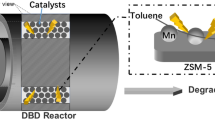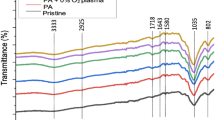Abstract
Manganese activated carbon (Mn-AC) was successfully prepared by the incipient wetness method and characterized by SEM, XRD, and FTIR. This study chose N,N-dimethylformamide (DMF) as the target pollutant, and the removal rate of DMF and removal mechanism were systematically studied by dielectric barrier discharge (DBD) plasma combined with Mn-AC. This study indicated that DBD plasma combined with Mn-AC could effectively remove DMF. With the addition of Mn-AC, the removal rate and mineralization rate of DMF within 40 min increased from 51.5% and 36.0% to 82.2% and 58.2%, respectively. The discharge power, initial concentration of DMF, initial pH of the solution, and dosage of Mn-AC affect the removal of DMF. The optimal discharge power is 16.19 W, and energy efficiency is 20.79 mg·kJ−1; low concentration DMF could be removed more effectively. Neutral and alkaline conditions showed better removal effect of DMF than acid conditions; Mn-AC optimal dosage is 1.0 g L−1. The concentration variations of O3, H2O2, and ·OH manifested that Mn-AC could effectively convert O3 and H2O2 to ·OH, thereby increasing the DMF removal rate. Quenching experiments showed that ·OH is the main active species in the reaction. Based on reaction products of DMF such as N-methylformamide, methanol, formaldehyde, and formic acid, possible degradation pathways were proposed. Prospect analysis demonstrated combining plasma systems with catalysts is promising.











Similar content being viewed by others
Data availability
Not applicable
References
Abbaszadeh HF, Moussavi G, Moradi M (2019) Advanced oxidation of formaldehyde in aqueous solution using the chemical-less UVC/VUV process: kinetics and mechanism evaluation. J Water Process Eng 27:120–125
Alvárez PM, García-Araya JF, Beltrán FJ, Giráldez I, Jaramillo J, Gómez-Serrano V (2006) The influence of various factors on aqueous ozone decomposition by granular activated carbons and the development of a mechanistic approach. Carbon 44:3102–3112
Einaga H, Ibusuki T, Futamura S (2001) Performance evaluation of a hybrid system comprising silent discharge plasma and manganese oxide catalysts for benzene decomposition. IEEE Trans Ind Appl 37(5):1476–1482
Fan JW, Wu HX, Liu RY, Meng LY, Sun YJ (2021) Review on the treatment of organic wastewater by discharge plasma combined with oxidants and catalysts. Environ Sci Pollut Res 28:2522–2548
Faria PC, Órfão JJ, Pereira MF (2008) Catalytic ozonation of sulfonated aromatic compounds in the presence of activated carbon. Appl Catal B-Environ 83:150–159
Feng JP, Zhang XL, Zhang G, Li J, Song W, Xu ZL (2021) Improved photocatalytic conversion of high−concentration ammonia in water by low−cost Cu/TiO2 and its mechanism study. Chemosphere 274:129689
Futamura S, Zhang A, Einaga H, Kabashima H (2002) Involvement of catalyst materials in nonthermal plasma chemical processing of hazardous air pollutants. Catal Today 72:259–265
Georgi A, Kopinke FD (2005) Interaction of adsorption and catalytic reactions in water decontamination processes: part I. Oxidation of organic contaminants with hydrogen peroxide catalyzed by activated carbon. Appl Catal B-Environ 58:9–18
Grosjean N, Descorme C, Besson M (2010) Catalytic wet air oxidation of N,N-dimethylformamide aqueous solutions: deactivation of TiO2 and ZrO2-supported noble metal catalysts. Appl Catal B-Environ 97:276–283
Grymonpre DR (1999) Aqueous-phase pulsed streamer corona reactor using suspended activated carbon particles for phenol oxidation : model-data comparison. Chem Eng Sci 54:3095–3105
Hao XL, Zhang XW, Lei LC (2009) Degradation characteristics of toxic contaminant with modified activated carbons in aqueous pulsed discharge plasma process. Carbon 47(1):153–161
Harling AM, Glover DJ, Whitehead JC, Zhang K (2009) The role of ozone in the plasma-catalytic destruction of environmental pollutants. Appl Catal B-Environ 90(1-2):157–161
Karuppiah J, Reddy EL, Reddy PM, Ramaraju B, Karvembu R, Subrahmanyam C (2012) Abatement of mixture of volatile organic compounds (VOCs) in a catalytic non-thermal plasma reactor. J Hazard Mater 237-238:283–289
Kogelschatz U (2003) Dielectric-barrier discharges: their history, discharge physics, and industrial applications. Plasma Chem Plasma Process 23:1–46
Kong Z, Li L, Wu J, Zhang T, L YY (2019) Insights into the methanogenic degradation of N, N-dimethylformamide: the functional microorganisms and their ecological relationships. Bioresource Tech 271:37-47
Li L, Kong Z, Xue Y, Wang TJ, Hiroyuki K, Li YY (2020a) A comparative long-term operation using up-flow anaerobic sludge blanket (UASB) and anaerobic membrane bioreactor (AnMBR) for the upgrading of anaerobic treatment of N,N-dimethylformamide containing wastewater. Sci Total Environ 699:134370
Li H, Li TF, He ST, Zhou J, Wang TC, Zhou L (2020b) Efficient degradation of antibiotics by non-thermal discharge plasma: highlight the impacts of molecular structures and degradation pathways. Chem Eng J 395:125091
Liu YN, Mei SF, Iya SD, Cavadias S, Ognier S (2012) Carbamazepine removal from water by dielectric barrier discharge: comparison of ex situ and in situ discharge on water. Chem Eng Process 56:10–18
Liu XW, Li WQ, Hu R, Wei Y, Yun WY, Nian P, Feng JW, Zhang AY (2020) Synergistic degradation of acid orange 7 dye by using non-thermal plasma and g-C3N4/TiO2: performance, degradation pathways and catalytic mechanism. Chemosphere 249:12603
Ma J, Sui MH, Chen ZL, Wang LN (2004) Degradation of refractory organic pollutants by catalytic ozonation - aActivated carbon and Mn-loaded activated carbon as catalysts. Ozone-Sci Eng 26:3–10
Ma S, Kim K, Chun S, Moon YS, Hong Y (2020) Plasma-assisted advanced oxidation process by a multi-hole dielectric barrier discharge in water and its application to wastewater treatment. Chemosphere 243:125377
Maciuca A, Batiot-Dupeyrat C, Tatibouet JM (2012) Synergetic effect by coupling photocatalysis with plasma for low VOCs concentration removal from air. Appl Catal B-Environ 125:432–438
Mustafa MF, Fu X, Liu Y, Abbas Y, Lu W (2018) Volatile organic compounds (VOCs) removal in non-thermal plasma double dielectric barrier discharge reactor. J Hazard Mater 347:317–324
Nisha NK, Devi V, Varalakshmi P, Ashokkumar B (2015) Biodegradation and utilization of dimethylformamide by biofilm forming Paracoccussp. strains MKU1 and MKU2. Bioresource Tech 188:9–13
Nohara K, Hidaka H, Pelizzetti E, Serpone N (1997) Processes of formation of NH4+ and NO3- ions during the photocatalyzed oxidation of N-containing compounds at the titania/water interface. J Photochem Photobiol A-Chem 102:265–272
Raju BR, Reddy EL, Karuppiah J, Reddy PMK (2012) Catalytic non-thermal plasma reactor for the decomposition of a mixture of volatile organic compounds. J Chem Sci 125(3):673–678
Ryu HW, Song MY, Park JS, Kim JM, Jung SC, Song J, Kim BJ, Park YK (2019) Removal of toluene using ozone at room temperature over mesoporous Mn/Al2O3 catalysts. Environ Res 172:649–657
Sang WJ, Cui JQ, Feng YJ, Mei LJ, Zhang Q, Li D, Zhang WJ (2019) Degradation of aniline in aqueous solution by dielectric barrier discharge plasma: mechanism and degradation pathways. Chemosphere 223:416–424
Tai C, Han D, Yin Y, Zhao T, Wang J (2015) Determination of photogenerated hydroxyl radicals in natural water by high performance liquid chromatography after trapping with dimethyl sulfoxide. Environ Chem 34:212–218
Tang SF, Li X, Zhang C, Liu Y, Zhang WT, Yuan DI (2019) Strengthening decomposition of oxytetracycline in DBD plasma coupling with Fe-Mn oxide-loaded granular activated carbon. Plasma Sci Technol 21:025504
Wang W, Fan X, Zhu T, Wang H, Ye D, Hong X (2016) Removal of gas phase dimethylamine and N,N-dimethylformamide using non-thermal plasma. Chem Eng J 299:184–191
Wang JL, Bai ZY (2017) Fe-based catalysts for heterogeneous catalytic ozonation of emerging contaminants in water and wastewater. Chem Eng J 312:79–98
Wang B, Chi C, Xu M, Wang C, Meng D (2017) Plasma-catalytic removal of toluene over CeO2-MnOx catalysts in an atmosphere dielectric barrier discharge. Chem Eng J 332:679–692
Wu P, Dai SQ, Chen GX, Zhao SQ, Xu Z, Fu ML, Chen PR, Chen Q, Jin XJ, Qiu YC, Yang SH, Ye DQ (2020) Interfacial effects in hierarchically porous α-MnO2/Mn3O4 heterostructures promote photocatalytic oxidation activity. Appl Catal B-Environ 268:118418
Xing ST, Zhou ZC, Ma ZC, Wu YS (2011) Characterization and reactivity of Fe3O4 /FeMnOx core/shell nanoparticles for methylene blue discoloration with H2O2. Appl Catal B-Environ 107(3-4):386–392
Yu XW, Somoza-Tornos A, Graells M, Pérez-Moya M (2020) An experimental approach to the optimization of the dosage of hydrogen peroxide for Fenton and photo-Fenton processes. Sci Total Environ 743:140402
Zhao Y, Ma L, Chang WK, Huang ZD, Feng XG, Qi XX, Li ZH (2018) Efficient photocatalytic degradation of gaseous N,N-dimethylformamide in tannery waste gas using doubly open-ended Ag/TiO2 nanotube array membranes. Appl Surf Sci 444:610–620
Zhang J, Liu DQ, Bian WJ, Chen XH (2012) Degradation of 2,4-dichorophenol by pulsed high voltage discharge in water. Desalination 304:49–56
Zhang Q, Xu R, Xu P, Chen R, He Q, Zhong J, Gu X (2014) Performance study of ZrO2 ceramic micro-filtration membranes used in pretreatment of DMF wastewater. Desalination 346:1–8
Zhang GY, Sun YB, Zhang CX, Yu ZQ (2017) Decomposition of acetaminophen in water by a gas phase dielectric barrier discharge plasma combined with TiO2-rGO nanocomposite: mechanism and degradation pathway. J Hazard Mater 323:719–729
Zhang ZJ, Zhou DB, Bao XJ, Huang GH, Tang Q, Huang BY (2019) One-pot facile synthesis of Mn3O4/C as an efficient and stable electrocatalyst for oxygen reduction reaction in alkaline solution. J Alloys Compd 777:872–876
Zheng K, Sun YB, Gong S, Jiang GL, Zheng XS, Yu ZQ (2019) Degradation of sulfamethoxazole in aqueous solution by dielectric barrier discharge plasma combined with Bi2WO6-rMoS2 nanocomposite: mechanism and degradation pathway. Chemosphere 222:872–883
Funding
This work was supported by the National Natural Science Foundation of China project 51108360 and 51208397.
Author information
Authors and Affiliations
Contributions
Wenjiao Sang: writing—review and editing. Longjie Mei: data curation, writing—original draft, writing—review and editing. Cheng Zhan: data curation, writing—original draft. Qian Zhang: visualization, investigation. Jin Xi: software, validation. Shaohui Zhang: conceptualization, methodology. Shiyang Zhang: supervision. Cuihua LI: visualization, investigation. Min Li: methodology.
Corresponding author
Ethics declarations
Competing interests
The authors declare no competing interests.
Ethical approval
Not applicable
Consent to participate
Not applicable
Consent to publish
Not applicable
Additional information
Responsible Editor: Ricardo Torres-Palma
Publisher’s note
Springer Nature remains neutral with regard to jurisdictional claims in published maps and institutional affiliations.
Supplementary Information
ESM 1
(DOCX 2309 kb)
Rights and permissions
About this article
Cite this article
Sang, W., Mei, L., Zhan, C. et al. Removal of N,N-dimethylformamide by dielectric barrier discharge plasma combine with manganese activated carbon. Environ Sci Pollut Res 28, 41698–41711 (2021). https://doi.org/10.1007/s11356-021-13729-5
Received:
Accepted:
Published:
Issue Date:
DOI: https://doi.org/10.1007/s11356-021-13729-5




